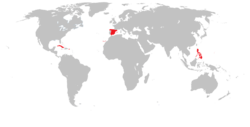This article has multiple issues. Please help improve it or discuss these issues on the talk page. (Learn how and when to remove these messages)
|
Spanish Republic República Española | |||||||||
|---|---|---|---|---|---|---|---|---|---|
| 1873–1874 | |||||||||
| Motto: Plus Ultra (Latin) Further Beyond | |||||||||
| Anthem: Himno de Riego Anthem of Riego | |||||||||
 | |||||||||
| Capital | Madrid | ||||||||
| Common languages | Spanish | ||||||||
| Religion | Catholicism | ||||||||
| Demonym(s) | Spaniard, Spanish | ||||||||
| Government | Federal semi-presidential republic | ||||||||
| President | |||||||||
• 1873 | Estanislao Figueras | ||||||||
• 1873 | Francesc Pi i Margall | ||||||||
• 1873 | Nicolás Salmerón | ||||||||
• 1873–1874 | Emilio Castelar | ||||||||
• 1874 | Francisco Serrano | ||||||||
| Prime Minister | |||||||||
• 1874 | Juan de Zavala | ||||||||
• 1874 | P. Mateo Sagasta | ||||||||
| Legislature | Congress of Deputies | ||||||||
| History | |||||||||
| 11 February 1873 | |||||||||
| 12 July 1873 | |||||||||
| 29 December 1874 | |||||||||
| Currency | Spanish peseta | ||||||||
| ISO 3166 code | ES | ||||||||
| |||||||||

| History of Spain |
|---|
 |
| Timeline |

The Spanish Republic (Spanish: República española), historiographically referred to as the First Spanish Republic (Spanish: Primera República española), was the political regime that existed in Spain from 11 February 1873 to 29 December 1874.
The Republic's founding ensued after the abdication of King Amadeo on 10 February 1873. On the next day a republic was proclaimed by a parliamentary majority made up of radicals, republicans and democrats. The period was beset by tensions between federal republicans and unitarian republicans. The period also saw the end of compulsory conscription, the regulation of child labor and the abolition of slavery in Puerto Rico. The government inherited a state of war, the so-called Third Carlist War, ongoing since 1872, and the Ten Years' War, ongoing since 1868, to which the Cantonal rebellion added up in 1873.
The January 1874 coup of Pavía ousted the government, giving way to a praetorian republic under General Serrano. In December 1874, General Arsenio Martínez Campos staged a pronunciamiento in Sagunto, which delivered the coup de grâce to the Republic and brought the Bourbon Restoration.

